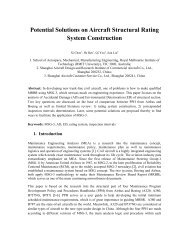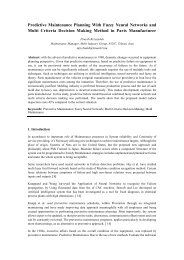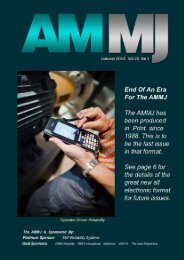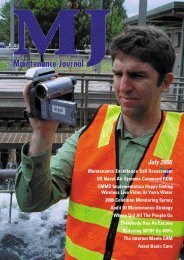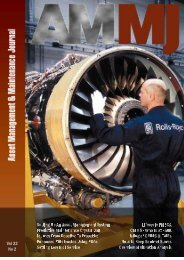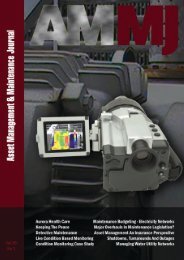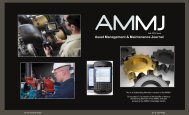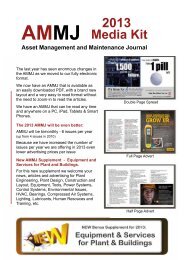July - AMMJ
July - AMMJ
July - AMMJ
You also want an ePaper? Increase the reach of your titles
YUMPU automatically turns print PDFs into web optimized ePapers that Google loves.
<strong>AMMJ</strong><br />
Lubrication Reliability<br />
14<br />
Many CMMS products allow for inclusion of a list or block of items with a PM, which can be used to list the lubrication<br />
points for an equipment area. Sounds simple doesn’t it? Unfortunately, the actual complexities of lubrication cannot<br />
be overlooked.<br />
Lubrication points within any equipment area are not identical. One key differentiator is the variation of frequency.<br />
Examples of such variation include some points being done weekly or biweekly, others monthly, bimonthly, quarterly<br />
or annually. A single PM can’t address this fact, this results in multiple PMs being created, one per frequency,<br />
for each equipment area. Equally important variations include the lubricant required, number of lube fittings, and<br />
activity type (top-off, change-out, sample, etc.). Further variation comes when activities require specific step-bystep<br />
procedural instructions. With the CMMS offering no native support for lubrication, how is such information<br />
conveyed using a single PM? How many PMs are needed to convey a bare minimum of these compulsory details?<br />
Remember, give a CMMS more PMs and it will return the favor with increased work-orders and paperwork. More<br />
importantly, within these numerous work orders and pieces of paper, there is no opportunity to bring optimization<br />
and efficiency to lubrication.<br />
What’s done is done. Or is it? Mark a work order as completed and the entire block of lubrication points share<br />
the same status. A PM system unable to function below the work-order level can’t remember the relevant “ all<br />
outstanding lubrication points” that must somehow be remembered over subsequent weeks until completed. It’s not<br />
hard to see this problem compounding week after week.<br />
Yes, having a multitude of detail deficient lubrication PMs might look and feel good on the surface, but it veils reality<br />
with a false sense of security. Once again, details required for success are left to the imagination and memory of<br />
lubrication personal. With such reliance upon manual effort, paperwork and human memory, it’s no surprise a recent<br />
search across popular CMMS/EAM websites for the term “lubrication” returned zero pertinent results.<br />
Customizing CMMS/EAM systems<br />
The fourth and by far the most costly approach is customization of the CMMS / EAM product for lubrication. Gaining<br />
rudimentary lubrication capability consumes hundreds of man hours, with one organization reporting having spent<br />
nearly $1,000,000 USD to modify a large EAM system so that it was capable of lubrication-point level of functionality.<br />
Even if successful, such customizations prove difficult and expensive to update. Personnel doing the original work are<br />
often otherwise assigned or no longer part of the organization. With corporations working to eliminate maintenance<br />
of in-house legacy systems, why should lubrication be any different?<br />
Counting The Cost<br />
Regardless of perception, it’s not a case of just the tin man with an oil can. In today’s competitive environment,<br />
the good old “Oil is oil” mentality does not suffice. This results in lubrication points being consistently maintained<br />
incorrectly, or worse yet, missed entirely. Yet management often declares or assumes lubrication to be in good<br />
order. You don’t get immediate feed-back when a lube point is missed. Often times it takes months or even years<br />
until the feed-back manifests as costly equipment failure and unplanned down time.<br />
This points to why over 50% of all equipment failures are traced back to poor lubrication practices. Numerous longterm<br />
studies in Canada, Germany, Russia, United Kingdom, and the United States declare this fact in unison.<br />
So this begs the question, why are these four approaches to lubrication so often employed? Organizations tend<br />
toward these approaches over a true lubrication reliability program for any of the following reasons:<br />
1. Lubrication Reliability not being understood as its own discipline<br />
2. Intuitive unease as to the detail and volume of activities required<br />
3. Management failure to calculate the cost of poor lubrication practices<br />
4. Management failure to calculate the payoff of lubrication reliability<br />
5. Lack of awareness of effective alternatives<br />
What is the net result of relying primarily on human memory? It is significant cost and loss. This includes unplanned<br />
downtime, capital equipment replacement, poor use of human resources and environmental risk. This is in addition<br />
to poor production quality and excessive energy consumption.<br />
Gaining The Benefits<br />
Responsibilities become clear and known<br />
What are the features and benefits of a well designed lubrication reliability software solution? Headaches and<br />
complexities are resolved. Maintenance planners and reliability professionals gain time to focus on other important<br />
initiatives. Most importantly, all lubrication specific details are clearly presented to lubrication personnel, ensuring<br />
lubrication is done right. That means: The right lubricant is used in the right place, at the right time, using the right<br />
procedure. Abnormal machine conditions are also noted, recorded and tracked until these conditions improve.<br />
Other important capabilities include: consumption tracking and trending, shutdown / outage planning and display of<br />
lock-out / tag-out safety information.<br />
Vol 24 No 3




